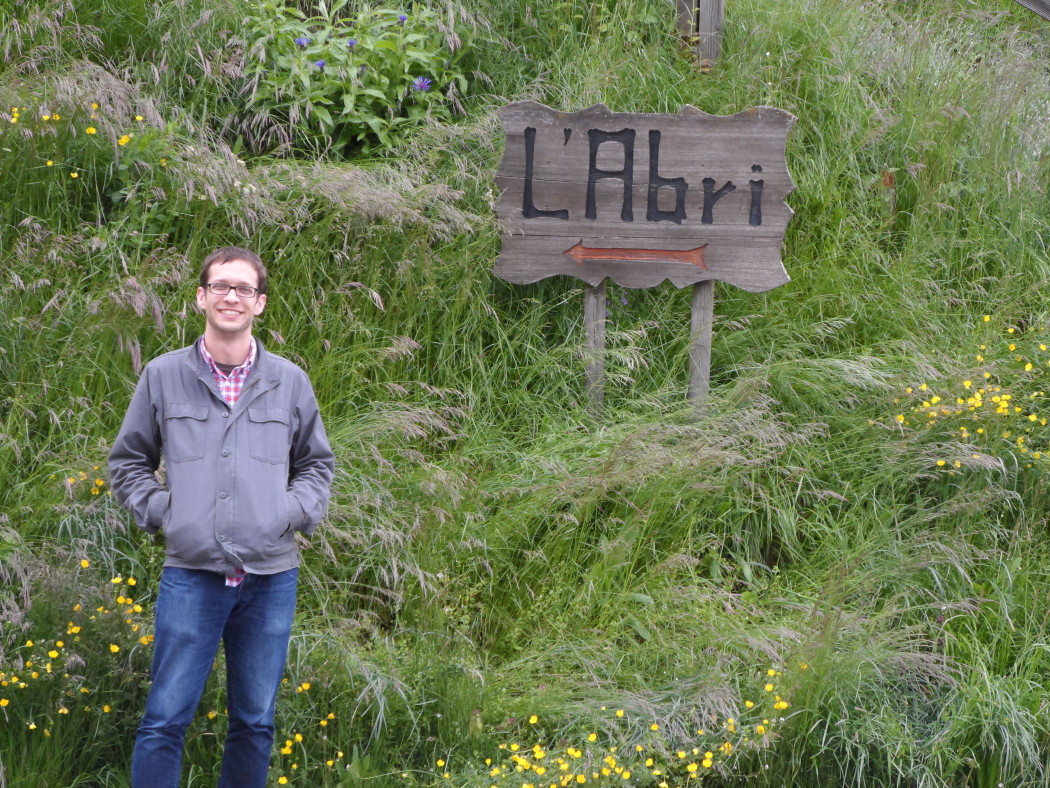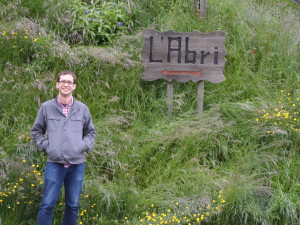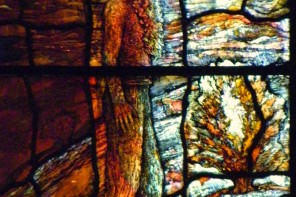My family and I recently spent some time at L’Abri in Huemoz, Switzerland.[1] While there, I gave two lectures, arguing that we might mimic the methodology of the Preacher in Ecclesiastes who, instead of speaking from Torah or existing wisdom, created new wisdom based upon his own observations of commonly observable, shared experience. Might we, like the Preacher, cultivate and create alternative wisdom traditions, experiential milieus within which we might make the gospel known through shared experience?
And why would we do that? Because people regularly accept experiences other than their own as their own, a sort of vicarious participation. We’ve all seen this before when a friend or family member quotes a movie, play or book, speaking the words as if they were their very own.
In my lecture, I identified two typical approaches to making the gospel known: data and testimony, the former being non-contextualized, the latter contextualized. Were we to begin with some non-contextualized data – “fear God and keep his commandments, because this applies to every person,”[Ecclesiastes 12:13] – we would certainly take a step towards the other (i.e., the non-believing hearer), but we would, in the end, fail to cross the divide between self and other. The data is, after all, other to both parties; put simply, it doesn’t connect with anyone’s experience, ours or theirs.
But what about testimony? Might it bridge the experiential divide? Yes, but not between us and them. Testimony brings data down to the realm of experience, but the experience is mine, not yours or anyone else’s. It is still other to the other.
But what if instead of data floating out in conceptual space, or testimony brought down to the level of our experience, we might make the gospel known from within the experience of the other? That, it seems to me, would, at the very least, take another step towards the other, and perhaps even more. To speak from within the experience of another is to do more than take a step towards that other; it is to be, in some sense, the other for the sake of other.
“Sounds great,” you say, “but how do we gain access to the experience of the other?” The Preacher begins with a poem, and in so doing, shows us the way from shared experience (1:3-11) through testimony couched in poetry (1:12-12:7) to data (12:13-14). Like the Preacher, I suggested we might use poetry and poetic forms like art to make the gospel known. And this is the point in the lecture when someone asked if this approach might not make art particularly susceptible to abuse (i.e., propagandizing).[2]
I’ve addressed this issue on Transpositions before,[3] but I’d like to have another go, and this time in conversation with George Pattison here in Part 1, and then with William Desmond in Part 2. Pattison reminds us that in seeking to use art we must begin by affirming the integrity of the artwork, and Desmond gives us a metaphysic that seems to support the approach of shared experience. We begin, then, with Pattison’s “Art and Apologetics” in which he notes:
“Serious apologetics can naturally never just be an attempt to reclothe the Christian message so as to make it more easily acceptable to a particular audience. Serious apologetics depends on the theologian recognizing that the themes and concerns of his partner in dialogue are in some way also his own.”[4]
Pattison continues, summarizing his argument as follows: “I should like to suggest four points [essential for considering art and apologetics]…. These four points can be summed up in the words: particularity, integrity, wholeness and pluralism.”[5] Now, it’s that second point that I’m particularly interested in: Integrity. By “integrity,” Pattison “mean[s] that the artist, and not just his or her medium, is bound by a very specific and very distinctive vision and way of working. The integrity of the art is the way in which the artist’s own individuality permeates and impresses itself upon the work.”[6] Now, we might debate his definition, but suffice it to say that affirming the integrity of the work is immensely important, and Pattison’s call serves as a sort of warning against use apart from uselessness.
But what, you say, underlies this assertion of integrity, and how are we to be assured that use does not become abusive? The answer exceeds the limits of this post, and so I’ll defer, answering in my next post.
Christopher R. Brewer is pursuing a PhD with David Brown and he is exploring the possibility of an imaginative natural theology. Along these lines, he is the founder and director of gospel through shared experience as well as the editor and publisher of Art that Tells the Story.
[1] For those not familiar with L’Abri, it is a study center that was founded by Francis and Edith Schaeffer in 1955. Some may recall Jim Watkins’s post, Christianity, Culture and the L’Abri Community, written this time last year while he and his family were living at L’Abri.
[2] My post in the recent Imaginative Apologetics Symposium, Gospel through Shared Experience, might serve as a sort of summary, and audio of the lectures will soon be available at www.gospelthroughsharedexperience.com.
[3] See Christopher R. Brewer, “A Response to Siedell’s ‘Art and Explanation'” and “Of What Use Is Story? Further Reflections Upon a Storied Theology of the Arts.”
[4] George Pattison, “Art and Apologetics,” Modern Churchman, 32 no. 5 (1991): 24.
[5] Ibid., 26.
[6] Ibid.







Chris, thanks for this post and raising the topic of how Christians use art for means like apologetics. I think that it is a really important topic. It is interesting that Pattison ties the intregrity of a work of art to the artist’s individuality. I suppose that is an important dimension of whatever one might mean by integrity, but I would have thought that the concept of integrity would be much larger than this, including things like the cultural/historical setting of the work, the tradition that informs the work and the reception of the work (by its original viewers, and subsequent generations). In short, I tend to think of “integrity” as “otherness.” It is all the ways that the work of art pushes beyond my attempts to use it for my own purposes, and so to use a work of art repsonsibly (to respect its “integrity”) means to recognize that this work of art is not ready made for my own purposes. What do you think of this more expanded way of thinking about “integrity”?
From what I read here, and I admit there are limits to what I can grok from this, this definition of integrity sounds very similar to Schaeffer’s use of “validity” in his _Art and the Bible_ essays. In order for the work to be valid, it has to come from the artist, the artists is being honest to himself, his worldview, what he creates, how he creates it, etc. The rest that you bring up is really beyond the control of the artist, I think, except in as much the artist is influenced (willingly or not) by culture, traditions, et. al.
Joe
Hi Joe, I can’t speak for Chris, but I’m not talking about Schaeffer’s idea of “validity.” When Schaeffer speaks about “validity”, he is talking about art from the perspective of the artist. What I said here about “integrity” or “otherness” is written from the perspective of one who uses (i.e. views, listens to, reads, etc.) art. So, thanks for bringing up “validity”, but I think we are talking about two different things. Perhaps Chris will have some thoughts about this…
Right, I meant Chris/Pattison’s definition sounds similar to Schaeffer’s.
Joe
From what I gather, you are talking about two different things. Integrity for you is assessed from the outside in— including things like the cultural/historical setting of the work, the tradition that informs the work and the reception of the work (by its original viewers, and subsequent generations).
Integrity/Validity for the author and Schaeffer, I take, as coming from the inside out—”The integrity of the art is the way in which the artist’s own individuality permeates and impresses itself upon the work.” and Schaeffer, “By validity I mean whether an artist is honest to himself and to his world view”
“to use a work of art repsonsibly (to respect its ‘integrity’) means to recognize that this work of art is not ready made for my own purposes.”
Hopefully the author will address this when he discusses abuse v. use. I would think part of this is also, not just respecting the exterior environments associated with a work, but also respecting the “interior” of the individual who created the work.
Joe
Jim, thanks for your thoughts and question regarding integrity. Several thoughts:
1) Before responding to your question, I want to be sure that we understand what Pattison is getting at. He begins: “Over the last few decades theologians have engaged in dialogue with a variety of non-theological disciplines and spheres of action such as psychoanalysis, Marxism, feminism and ecology. The aim of this article is primarily to recommend the visual arts as a suitable case for such apologetic treatment. Serious apologetics can naturally never just be an attempt to reclothe the Christian message so as to make it more easily acceptable to a particular audience. Serious apologetics depends on the theologian recognizing that the themes and concerns of his partner in dialogue are in some way also his own.”[p. 24] Those last two sentences are incredibly important, both as context for Pattison’s article as well as a sort of frame for our conversation here. The gist of those two sentences, it seems, is that the conversation of art and apologetics is a dialogue, i.e., two-way. And here I can’t help but think of a couple sections from our supervisor David Brown, the first from his God and Enchantment of Place and the second from his God and Mystery in Words. Brown notes: “Culture needs to return as a Christian concern, but one where as much time is spent listening as in trying to contribute.”[p. 2] And along these same lines: “So far as possible, I want to engage in as open a dialogue as possible with the wider culture of both past and present, and not simply impose predetermined answers.”[p. 2] The point for Pattison, and Brown too, then, is that we must not “impose predetermined answers” (i.e., use art), but enter into dialogue with it, and as Pattison notes, this means recognizing that the themes and concerns of art are in some way also our own. A but further on, Pattison notes: “A serious apologetic concern with art will be more concerned to identify points where what is being done in art testifies to a profound community of interest rather than trying to promote itself at the expense of art. Only when Christians take the trouble to recognize such common ground will artists be enabled to regard Christianity as a viable option which does not require them to sacrifice their own artistic integrity.”[p. 26] It is at this point that Pattison discusses his four points: particularity, integrity, wholeness and pluralism. Regarding particularity, he notes: “Visual art is always particular. It has an object quality, a ‘thereness’ or concreteness which requires of us a very particular kind of attention. Faced with an image in stone or paint we have to look at what is there. We are confronted with an actual presence. Although this might also be said of some kinds of literature, especially poetry, the very materiality of the elements with which a painting or statue is composed involve us in a quite different relation to it than that which we have to the written word…. Language inevitably negates the given but a work of art is a given and our response to it must commence with a recognition of it in its givenness.[pp. 26-27] He concludes this section, noting: “Art recalls us to the contingency of the earthly stuff in which and with which it works, and of which we too are made. Both art and Christian theology makes us aware of our essential creatureliness.”[p. 27] And here Pattison turns from particularity to the closely connected characteristic of integrity. I’ve already quoted the opening sentences of this paragraph in my post, and it was these sentences with which your question had to do. That said, I’d like to go a bit further into this section’s three paragraphs before addressing your question more directly. After defining integrity as the artist being “bound by a very specific and very distinctive vision and way of working…. the way in which the artist’s own individuality permeates and impresses itself upon the work,”[p. 27] Pattison goes on to give several examples: Monet, Rothko and Picasso. Regarding Monet’s paintings of his garden at Giverny, Pattison notes that they “reveal the total commitment of the artist to his subject matter, his way of seeing it and his way of painting it.”[p. 27] Regarding Rothko, Pattison mentions “the consistency and dedication with which Rothko pursued his theme,”[p. 27] and regarding Picasso, a “distinctive way of seeing and making.”[p. 28] Having considered these examples, Pattison comments: “If the material particularity of art is a balance to the one-sided rationality of the modern world, its integrity is a vital resource in withstanding the tendency to fragmentation which afflicts contemporary life.”[p. 28] He goes on to describe this integrity as “a kind of fearlessness,” “a kind of integrity which does not flee from the finitude of the self but finds in this very finitude the condition of all authentic achievement.”[p. 28] Finally, Pattison notes: “where art is true to its own particularity and where it shows real integrity it embodies something of the quest for wholeness in which the religious individual is also involved, no matter to what extent the artist may consciously define his art as as art of protest or negation.”[p. 28] The article concludes with a call for balance (i.e., dialogue) between theology, often shorthand for a theology of the Word, and art and the visual dimension of theology. From this summary, it should be clear that Pattison’s notion of integrity has mainly to do with a sort of artistic particularity and persistence, a pursuit that “embodies something of the quest for wholeness.” What I appreciate about this article is Pattison’s insistence that art be acknowledged as dialogue partner requiring “a very particular kind of attention,”[p. 26] different from the written word (i.e., its meaning being “embodied in its material actuality”[p. 27]), but not cut off from the dialogue as if to be an other in dialogue means pursuing a sort of self-interested dialogue. That is, after all, what Pattison is speaking against (i.e., with regard to theology). We can’t, in other words, come from theology to art with our agenda. We must acknowledge the concerns of the other as our own. And yet, at the same time, and this is the crux of my argument, neither should art respond to theology as if the concerns of theology were in some sense secondary or completely other to its own. The dialogue runs both ways, theology acknowledging the concerns of art as its own, and art acknowledging the concerns of theology as its own; put differently, and related to the conversation I’ve been having, use (i.e., the concerns of the other amongst other things) couched in uselessness (i.e., art as art in all its particularity, integrity, etc.).
2) And this gets at your thoughts and question. Ready made for my own purposes or concerns? Absolutely not. This sort of use fails to acknowledge the other as other. But if we, as Brown suggested, begin by listening instead trying to contribute (i.e., use), it seems that we might hear the concerns of the other as our own, and vice versa, resulting in a dialogue (i.e., use couched in uselessness) that moves, and this is getting into my next post, from the univocal to the equivocal to the dialectical to the metaxological. William Desmond explains: “The univocal sense tends to emphasize determinate sameness and identity; the equivocal tends to emphasize difference that escapes univocal sameness, sometimes even to the point of indeterminacy, and the loss of any mediation between sameness and difference, identity and otherness. The dialectical sense seeks to mediate differences, differences sometimes equivocal, but not by reduction to univocal sameness, but by transition to a more inclusive unity which, it is claimed by some, contains and even reconciles the differences. The metaxological sense, properly speaking, stresses the between and deals with the interplay of sameness and difference, identity and otherness, not by mediating a more inclusive whole but by intermediating a community of open wholes, allowing recurrence to the rich ambiguities of the middle, and with due respect for forms of otherness that dubiously claimed to be included in the immanence of the dialectical whole.”[The William Desmond Reader, pp. 197-198] You’ll have to bear with me, giving me the benefit of the doubt so that I can explain a bit more in my next post, but generally speaking, it seems as though theology and art often reach that second stage, the equivocal, where difference is emphasized to the exclusion of sameness resulting in a loss of mediation. And there are plenty of good reasons for this tendency, past abuses not least among them. That said, a reactionary and defensive posture closed off to dialogue and the integrity of use (i.e., use couched in uselessness) seems, to me, short-sighted and just plain unhelpful. So, to answer your question, I think that I’d be, more or less, comfortable with your expanded way of thinking about integrity, and here again, as I noted in my post, we could certainly debate Pattison’s definition in this particular article. Hopefully the summary above gives him the benefit of the doubt so that if we choose to debate his definition we actually know what that definition is, but I don’t see nailing the definition of integrity as being of primary importance here. More important, it seems, it to acknowledge the need for dialogue. The rules of the dialogue, the concerns of the other, etc. all follow. My concern in this post, however, was to argue for that first bit. I don’t mean to say that the question of integrity is unimportant, only that my argument doesn’t depend on one definition or the other. Is that helpful?
Sorry for the length of my reply, but I wanted to be sure to give Pattison a fair hearing, and then to respond from the piece we’re discussing.
I neglected to mention, in my discussion of Pattison and Brown, Brown’s essay “The Glory of God Revealed in Art and Music: Learning from Pagans” (in Celebrating Creation, ed. M. Chapman, Darton, Longman and Todd, 2004). That essay seems a natural next step after reading Pattison’s “Art and Apologetics.” Brown notes: “A constant temptation among Christians when looking at art or music is to view their role, when legitimate, as at most illustrative, confirming or deepening faith but never challenging or subverting it.”[p. 44] Drawing upon Jesus’ encounter with the Syrophoenician woman, Brown states: “Jesus, if I am right, learnt from a pagan; might not we also?”[p. 45] It is worth noting that by “pagan” Brown means “those who appear beyond the bounds of Christian orthodoxy but still engaged with the question of God.”[p. 45] That said, he concludes: “the deepening of our faith comes not only from within the resources of Christianity but also much more widely, from those of different religious beliefs and sometimes even from those of none…. Art and music need to be viewed and heard and valued in their own right. The glory of God lies in a love supreme that speaks everywhere, sometimes confirming what we already believe but sometimes too challenging or even undermining what we suppose to be the case. Jesus learnt the value of pagan ‘dogs’; can we?”[p. 55]
Chris, thank you for this thoughtful and very informative reply. I am fully on board with the idea that theologians should engage with the arts in a genuine dialogue. While I think your right that this is the more important point, there is still the issue of how one holds this dialogue, or, to put it another way, how one respects the integrity of the other. This was the point I was trying to make by suggesting that respecting the integrity of art should involve more than just the respecting the artist’s “distinctive vision and way of working.” At any rate, we seem to be largely in agreement and I look forward to your next post!
Jim, thanks for your kind reply. I think we are very much in agreement, and yes, I do think it necessary to define what we mean by integrity, but for the purposes of this post, that seemed secondary to my more primary aim; namely, to call for dialogue (i.e., between art and theology, and more specifically apologetics). If I don’t address the issue of definition to your satisfaction in my next post – I already have my hands full trying to explain Desmond! – I’d be happy to explore it with you in a future post.